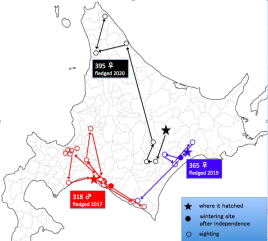
Banding
We attach uniquely numbered bands for identification of individual cranes.
By observing banded individuals, we learn vital information about ecology
of red-crowed cranes.
Attaching a tag with a unique number is a good way to identify individual wild animals without disturbing their activities. With birds (including cranes), the numbered tag comes in the form of a metal or plastic band attached to a leg. Identification of individuals is a valuable method for collecting information that cannot be obtained otherwise. Examples of such information are the life span, survivorship, and movement of individuals.
Attaching a tag with a unique number is a good way to identify individual wild animals without disturbing their activities. With birds (including cranes), the numbered tag comes in the form of a metal or plastic band attached to a leg. Identification of individuals is a valuable method for collecting information that cannot be obtained otherwise. Examples of such information are the life span, survivorship, and movement of individuals.

Capturing cranes
Capturing adult cranes involves some risks. Thus, we have focused on capturing chicks and juveniles before they learn to fly (up to about two months after hatching).
Capturing adult cranes involves some risks. Thus, we have focused on capturing chicks and juveniles before they learn to fly (up to about two months after hatching).
 Banding & measurement
Banding & measurementDuring banding and measurement, we use a head-cover so as to reduce the stress level of captured birds.

Release
Once released, the banded bird rejoins its parents.
Once released, the banded bird rejoins its parents.
 Old bands
Up until 2004, we attached a small metal band on the right leg and a large
plastic band on the left leg. However, the plastic band tended to get damaged
and fall off.
Old bands
Up until 2004, we attached a small metal band on the right leg and a large
plastic band on the left leg. However, the plastic band tended to get damaged
and fall off.

New bands
Since 2005, we have been attaching one large metal band on the right leg. The band is made of aluminum alloy.
Since 2005, we have been attaching one large metal band on the right leg. The band is made of aluminum alloy.
 Findings
FindingsAs the number of records of banded individuals increase, we are able to update our understanding about the ecology of the cranes.
The banding project started in 1988. The bands have been supplied by Yamashina Institute for Ornithology. Many volunteers have supported the banding project. With our continuing effort, currently more than 10% of individuals in the population can be identified using the bands.
タンチョウ保護研究グループタンチョウ保護研究グループ
〒085-0036
北海道釧路市若竹町9-21
TEL 0154-22-1993
FAX 0154-22-1993
Red-crowned Crane Conservancy
9-21 Wakatake-Cho,
Kushiro, Hokkaido 085-0036
JAPAN
TEL +81-154-22-1993
FAX +81-154-22-1993
あなたは
番目の訪問者です。